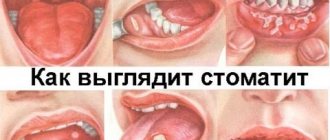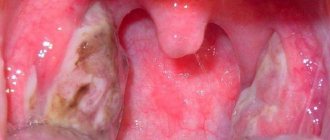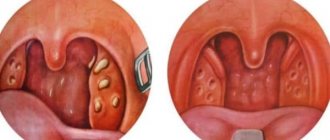Causes of pathological rashes ↑
Bubbles in the pharynx and larynx can form as a result of the following diseases:
- follicular sore throat, the most common cause of blisters and red spots in the throat;
- chronic inflammatory processes in the larynx;
- throat abscesses;
- stomatitis due to herpes;
- viral infections, including chickenpox.
As a rule, children suffer more often from the appearance of pimples, since their immune system is weaker, and the soft tissues of the pharynx are looser and more susceptible to the emergence of a particular virus.
Causes and treatment methods for black spots on the tonsils?
Very often, with a sore throat or other diseases, the symptoms of which are a red throat with painful sensations when swallowing, the patient examines his tonsils in front of the mirror.
And sometimes you have to notice not only the redness of the pharynx, but also holes in the tonsils. Of course, this phenomenon is quite pleasant, however, there is no need to panic.
It occurs often with sore throat, and the first thing to do is run to the doctor.
Often, these holes can develop pus, causing your breath to smell bad. Also, near the holes, white formations similar to stomatitis may appear along with pus. In addition, purulent plugs may peek out from these holes. Identifying them is not so difficult, since bad breath will be felt not only by those around you, but also by the sick person himself.
However, holes in the tonsils may not appear completely. If a person notices plugs in his throat, then the holes themselves can be so deep that they simply cannot be seen with the naked eye. Also, many people do not notice these holes just because they are clogged with pus.
Holes in the tonsils indicate that an inflammatory process is occurring in the body.
If they come out, then you should not try to remove them yourself. Many people try to squeeze out the pus that forms there with their own hands in front of a mirror. Of course, a small part of it is squeezed out, but most of it remains inside, and besides, when performing this procedure, infection can be introduced.
Causes
Very often, holes in the tonsils appear with chronic tonsillitis; some doctors even classify the appearance of depressions as symptoms of this disease. There is no point in trying to remove them yourself - it will not only be ineffective, but can also be harmful. In some cases, it is possible to prevent the appearance of holes, however, only for a short time; after a few weeks they will appear again.
The main reason for the occurrence of such a symptom can be called the ingress of harmful bacteria. They usually enter through the mouth or nose. Holes may also appear due to the course of the inflammatory-purulent process in neighboring organs.
Also, often formations of different sizes on the tonsils remain after the plugs are removed. Although if treated in a timely manner, they can be cured quickly. However, if you do not maintain oral hygiene, then over time new holes may form in place of the holes.
As mentioned above, the main cause of this symptom can be called chronic tonsillitis, against the background of which the patient may develop phlegmonous tonsillitis.
What can be dangerous: possible complications
If tonsils with holes are ignored, the consequences can be very serious and even life-threatening. It's all about the high risk of infection getting from purulent lacunae into the blood. This can cause the following complications:
- cystitis;
- inflammatory process in the kidneys;
- persistent sore throat;
- toothache;
- pathological processes in the nasopharynx;
- inflammation of the respiratory tract;
- problems with the gastrointestinal tract;
- meningitis.
Purulent tonsils, as a constant source of infection, are very dangerous due to their close connection with the digestive, respiratory and circulatory systems.
Untimely and incorrect treatment can lead to an increase in the number of holes in the tonsils and an increase in the inflammatory process. [ads-pc-1][ads-mob-1]
Difficulties
Of course, the appearance of holes in the tonsils is an unpleasant phenomenon in itself. Moreover, food can constantly get into them, thereby creating favorable conditions for the development of infection. This can cause bad breath to worsen as food rots in the recesses. That is why contacting a doctor should be immediate.
In addition, in these holes, food can roll into balls that roll out on their own. But if for some reason they did not appear outside, you need to remove them from there yourself.
Many people, seeing holes in their tonsils, decide to remove them. However, this is completely wrong; everything can be cured without resorting to surgical treatment.
After all, the tonsils perform one of the important functions - they do not allow many bacteria into the body that enter every day when a person breathes.
That is, by removing the tonsils, a person will constantly get sick and the immune system will be able to fight diseases on its own.
Removing tonsils is allowed only if they are completely lost, which is extremely rare. Sometimes the doctor may prescribe partial removal of the tonsils in places where the plugs cannot be removed.
As we can see, holes in the tonsils are not such a rare phenomenon, and many methods and drugs have been invented to combat it. Medicine does not stand still, and this allows you to preserve your health and preserve many organs.
>Why do holes appear in the tonsils?
Treatment of chronic tonsillitis
Among the methods of treating chronic tonsillitis are:
- Conservative (antibacterial, anti-inflammatory drugs, physiotherapy).
- Surgical (tonsillectomy, that is, removal of the tonsils).
Antibiotics (Augmentin, Ceftriaxone) are indicated only for exacerbation of sore throat. The basis of conservative treatment is washing the tonsils with antiseptics (Chlorhexidine, Furacilin). Gargling with infusion of chamomile, calendula, and immunomodulators (IRS-19) is also used. Physiotherapy includes laser therapy, magnetic therapy.
The choice of treatment depends on the form of the disease. Tonsils are a source of chronic infection, and if they are riddled with holes and purulent plugs, it is unlikely that it will be possible to cure the patient conservatively. Only a doctor can confirm any of the assumptions regarding the formation of holes in the tonsils after an objective examination and questioning.
Source: https://cosmeton.ru/drugoe/zheltye-pyatna-v-gorle-foto.html
Follicular tonsillitis ↑
Most often, pimples are diagnosed with follicular tonsillitis; it is the most dangerous among all types. The pathology is accompanied by inflammation of the back wall of the pharynx and tonsils with the appearance of small blisters on them. The latter are follicles, in other words small lymph nodes.
- Signs of this type of sore throat will be:
Follicular tonsillitissevere sore throat, difficulty swallowing saliva, water or food;
- fever with high temperature;
- red spots and pimples in the throat;
- migraine-type headache;
- pain in joints, muscles, body aches.
All symptoms appear acutely and in the very first hours of the disease. Sore throat is especially severe in children; there are frequent cases of asphyxia due to swelling of the pharynx, so if you suspect a disease, you should immediately call an ambulance.
The use of antiviral or antibacterial drugs depends on the causative agent of the infection. If the pathology is caused by bacteria, the main drug in treatment is an antibiotic, respectively, in the case of a virus, the disease is treated with the help of antiviral agents. In addition, symptomatic therapy with the use of antipyretics and analgesics is necessary. Bed rest with isolation from healthy people, plenty of warm drinks, irrigation and gargling are recommended.
Features of treatment
If we are talking about pharyngitis, then in this case you cannot do without antibacterial drugs. For chronic diseases of the pharynx (for example, granulomas or pharyngitis), complex treatment is additionally carried out, including the use of immunostimulants and physiotherapeutic procedures. If purulent abscesses have been diagnosed, then in this case a minor operation will have to be performed. The surgeon opens the abscesses and cleans them out. After this, it is necessary to take a course of antibiotics, as well as use the means that are necessary for detoxification. Also, after opening the ulcers, a study of the discharge must be carried out. If it is determined that they contain a fungal infection, then additional antifungal drugs will be required. During this period, a person must remain in bed, drink as much water as possible and adhere to the diet that the doctor will prepare for him.
If a person notices that he has a red throat, red bumps on the tongue and inflamed tonsils, and the doctor suspects a sore throat, then treatment can be more gentle, without the use of antibiotics. As a rule, anti-inflammatory drugs are sufficient for this. However, in more serious situations, the doctor may prescribe ultraviolet or laser treatment, as well as some physical therapy procedures.
If we are talking about frequent relapses, then in this case, the use of a laser or another type of surgical intervention will certainly be required. For stomatitis, antiviral drugs and vitamins help get rid of pimples in the back of the throat. Additionally, the person is prescribed medications that help improve the body’s protective functions. Accordingly, the immune system will work much better.
Rinsing helps get rid of the disease. For example, you can prepare a solution of furatsilin. To do this, two tablets of the product must be dissolved in 0.5 liters of boiling water. Experts also recommend using streptocide solution for rinsing. It, like furatsilin, is an excellent antiseptic that quickly destroys harmful bacteria and prevents them from multiplying.
It is best to perform the rinsing procedure as often as possible. Doctors usually recommend at least 10 rinses per day until the body’s full functioning is fully restored. If the course of treatment is interrupted as soon as a person has experienced minor relief, the bacteria may begin to multiply again. Therefore, it is better to carry out more treatment procedures.
If the throat is red and has pimples, then you can also use Lugol's solution. This composition perfectly cleanses the mucous membrane. However, it is worth considering that this product consists of a mixture of iodine and glycerin. Therefore, people suffering from allergies need to be careful. You should first consult with a specialist. In some situations, doctors allow the use of “grandmother’s recipes.”
Herpetic sore throat ↑
It also begins acutely and occurs predominantly in adults. The main manifestations of this disease are:
Herpangina
- high temperature 40-41 degrees;
- dysphagia and suffocation;
- the appearance of small, white blisters on the tonsils, which ulcerate and suppurate as the disease progresses;
- pain and difficulty swallowing.
As a rule, general symptoms persist for 6 days, after which they subside; blisters may persist a little longer. Recovery with proper treatment occurs without complications. As with the follicular form, the causative agent of the infection must be determined for therapy, after which an action plan for the patient’s recovery must be prescribed. Isolation of the patient is mandatory, since the infection is transmitted by airborne droplets.
Drug treatment
Treatment is complex and depends on the cause and additional symptoms
If pus occurs in the throat, symptomatic treatment and elimination of the causative agent are necessary. Treatment should be prescribed by a doctor after examination and medical history. Treatment, as a rule, is complex and lasts from 1 to 4 weeks, depending on the disease and the severity of its course.
Treatment always begins with diagnosis. If pus appears, you should contact an otolaryngologist. He will conduct an examination, collect anamnesis, and prescribe tests (blood tests, throat smear for bacterial culture).
Most often, treatment of purulent throat diseases includes the following components:
- Antibiotics. Pus usually signals a bacterial infection. Before prescribing antibiotics, an examination is carried out to determine the type of microorganisms and their sensitivity to a particular drug. Antibiotics are prescribed in courses of 3 to 10 days, depending on the age and condition of the patient. For bacterial infections of the throat, Amoxicillin, Azithromycin, Ciprofloxacin, Suprax, Sumamed are recommended. When taking antibiotics, it is advisable to immediately take a course of probiotics to avoid side effects in the form of dysbiosis.
- Topical sprays and lozenges. Local medications to eliminate inflammation are quite effective for pharyngitis, tonsillitis, sore throat, and laryngitis. They help relieve swelling, redness, soften the throat and fight the pathogen at the local level. For the treatment of purulent diseases, Miramistin, Tantum Verde, Cameton, Strepsils, Hexoral, Faringosept are prescribed. Sprays and lozenges should not be used uncontrolled. They are used no more than 4 times a day for 4-8 days. Local medications not only help eliminate pain and soothe a sore throat, but also have an anti-inflammatory effect.
- Gargles. For purulent inflammations in the throat, rinsing with a solution of hydrogen peroxide, Furacilin, Lugol, Miramistin is considered the most effective. They quickly and effectively relieve inflammation, destroying all pathogenic microbes.
- Antipyretic. At high temperatures (above 38 degrees), it is necessary to bring it down with antipyretic drugs such as Nise, Ibuprofen, Ibuklin. They are accepted not by courses, but if necessary.
When treating, it is important to observe frequency and adhere to the doctor’s recommendations. If treatment does not help, then in serious cases surgery to remove the tonsils is recommended.
Folk remedies
Gargling will help clear yellow lumps from your tonsils.
Drug treatment of the throat is often combined with folk remedies. They complement the action of drugs and have a general strengthening effect.
In some cases, folk remedies can cause a severe allergic reaction and increase swelling. Before using them, you should consult your doctor.
The most effective folk remedies for treating a throat are:
- Herbal decoctions. For inflammation of the throat or tonsils, you can gargle with a decoction of chamomile, sage, St. John's wort, and plantain. It is also recommended to make hot inhalations with herbs, take them orally, and add them to tea.
- Lemon. Lemon is a good remedy for treating many infectious diseases. In case of severe inflammation of the throat, it is not recommended to use it in its pure form, as citric acid can cause a burn to the mucous membrane. You can gargle with lemon juice diluted with water. You can add a slice of lemon to warm tea.
- Honey. Honey softens the throat and has a pronounced anti-inflammatory effect. It can be taken in its pure form, added to drinks, and medicines made from it. However, honey is a strong allergen.
- Milk and butter. Milk with butter has long been a known way to treat sore throats and colds. It should be drunk in the evening before bed. The milk must be boiled and cooled until warm, add butter. Hot milk may increase throat irritation.
- Aloe. To get rid of a sore throat, you need to take an aloe leaf, squeeze out the juice and dilute with the same amount of water. You need to gargle with this solution 3-4 times a day. The solution is stored for a day in a cool place.
More information about follicular sore throat can be found in the video:
Dry throat: medication and alternative treatment
When using folk remedies, you must adhere to the recommended dosages. If signs of an allergy appear or your health worsens, you should stop treatment and consult a doctor.
Particular care should be taken when treating pregnant women and young children with folk remedies. They are especially prone to allergic reactions.
It is not recommended to use herbs and honey when treating children under 2 years of age.
You also need to remember that some folk remedies are prohibited from being used for purulent infections. For example, in case of bacterial infections of the throat, it is strictly not recommended to apply mustard plasters.
Pharyngitis ↑
Another pathology in which bubbles appear on the walls of the pharynx. Often, with pharyngitis, even after recovery from the disease, bubbles on the back wall remain for several days or even a month. There are two types of pharyngitis: acute and chronic. Acute pharyngitis without proper treatment quickly becomes chronic. The main symptoms include:
- dry throat;
- soreness;
- pain when swallowing;
- the appearance of pimples and red spots in the throat;
- elevated temperature;
Pharyngitis - weakness and malaise.
Treatment of the disease consists of the use of anti-inflammatory, analgesic, and antiseptic agents. Gargling with infusions of chamomile, sage, and calendula has a beneficial effect. Spraying the pharynx with antiseptic solutions, for example, stopangin, orasept, propolis, etc. Local antiseptics in the form of lozenges, strepsils, septolete, and faringosept are also widely used. Lozenges have low activity; they are used as an addition to the main therapy and for mild forms of pathology.
Algorithm of action when a lump is detected in the throat
You can detect a lump on the back of the throat at home by visual inspection. If you experience discomfort while breathing, eating, or have a lump in your throat, you should examine your mouth with a mirror.
After identifying a lump, it is necessary to exclude provoking factors, monitor the cleanliness of the oral cavity, and consult a doctor. The specialist will conduct the necessary studies that will help determine the cause of development and the nature of the disease: pharyngoscopy, MRI, biopsy.
To eliminate the tumor, a course of therapy is prescribed taking into account provoking factors, the individual characteristics of the patient, and the nature of the tumor. It is not recommended to resort to self-medication or removal of the lump. Incorrect, untimely treatment can lead to the development of undesirable consequences, complications and death.
Abscess ↑
As a rule, an abscess forms against the background of a previous sore throat or pharyngitis, but there are cases when the pathology occurs as a result of banal hypothermia or infection. Main signs of an abscess:
- heat;
- a sore throat;
- difficulty swallowing, sometimes difficulty breathing, stridor;
- muscle and headache.
Throat abscess
The symptoms are acute; visually, swelling forms in the pharynx with an accumulation of purulent contents. The surface of the abscess is covered with red spots and often a white coating on them, the structure is loose, and when pressed, purulent contents with an unpleasant odor are released.
Treatment of an abscess occurs in a hospital setting, surgically. The abscess is opened and purulent contents are released from it. The procedure is performed under local anesthetic. After the procedure, antibacterial therapy, antihistamines, and detoxification agents are prescribed. In addition, systematic gargling with antiseptic solutions, physiotherapy (UVR), and plenty of warm drinks are required. The prognosis is favorable, recovery occurs after two weeks.
Diseases that cause a lump in the throat
A tumor in the throat indicates the development of an inflammatory process in the body.
As a result, diseases such as paratonsillitis, retropharyngeal abscess, syphilitic chancre, benign or malignant tumor develop.
Peritonsillitis
The disease is an inflammatory process that affects the tissue near the tonsils. Pus begins to secrete and accumulate in the form of a lump. The disease occurs when an infection occurs, as a complication after a purulent sore throat or throat disease.
Manifestations of paratonsillitis include several symptoms:
- the appearance of pain while eating;
- change in voice timbre;
- increased body temperature;
- feeling of unpleasant odor from the mouth;
- enlarged lymph nodes;
- general malaise.
Pain syndrome develops when turning the neck or opening the mouth.
Retropharyngeal abscess
The disease develops as a result of exposure to pathogenic microorganisms. It often occurs in children under 2 years of age.
The main signs of an abscess are: pain when eating or swallowing saliva, when turning the neck, impaired breathing, hoarseness in the voice, increased body temperature, general malaise, asphyxia.
Syphilis
Characteristic signs of the development of syphilis are the formation of lumps on the back of the throat or on the tonsils. A chancre is a painless tumor with a diameter of about 2 cm and a dark pink color. There is a small depression in the middle of the tumor.
The main sign of the occurrence of chancroid is the development of an inflammatory process in the lymph nodes.
Inflammation of the salivary glands
When pathogenic bacteria enter the oral cavity, an inflammatory process develops. It is capable of affecting the endocrine system, the glands that produce saliva.
The disease is characterized by the appearance of a dense formation, pain while eating, breathing, opening the mouth, dryness and bad breath, redness of the skin in the area of the lump, mucus formation, purulent discharge from the tumor, general malaise, and weakness of the patient.
Inflammation of the lymph nodes
Lymph nodes are one of the components of the immune system. Compaction occurs as a result of exposure to pathogenic microorganisms, the waste products of which accumulate in the lymph nodes. They become inflamed and increase in size. Neoplasms can be provoked by diseases of the oral cavity, tonsillitis, otitis media, and abscess.
Benign formations
Lumps in the throat appear as a result of the proliferation of internal tissues that form benign formations.
The most common benign tumors are:
- folliculitis is an inflammatory process that affects the hair follicles;
- a cyst occurs as a result of blockage of the sebaceous and sweat glands, the spread of infection to the external tissues;
- lipoma occurs in adipose tissue, it has clear boundaries, soft consistency and is painless;
- atheroma appears in clogged sebaceous glands, the neoplasm is characterized by a specific odor, it comes from the inflamed area;
- angioma is formed as a result of dental diseases, which are characterized by the proliferation of blood and lymphatic vessels.
A benign formation of the larynx is characterized by soreness, dryness, the sensation of a foreign body in the throat, and discomfort when swallowing. The tumor has clear boundaries, soft consistency, and is painless upon examination.
Malignant tumors
Cancer is characterized by symptoms such as:
- lump in throat;
- painful sensations when eating food, breathing;
- hoarseness in the voice;
- purulent odor from the mouth;
- during a cough, sputum is released, in which there is an admixture of pus and blood;
- severe headache;
- constant weakness;
- sudden weight loss;
- enlarged lymph nodes.
A malignant tumor can increase in size, bleed, and become painful.
Candidiasis
The causative agent is a fungus of the genus Candida.
Candidiasis is a fungal disease characterized by the appearance of a yellow layer on the oral mucosa. The disease occurs during pregnancy, long-term use of antibiotics, with decreased immunity, after radiation and chemotherapy, with dysbacteriosis and non-compliance with hygiene requirements.
Make an appointment with a mycologist
In some cases, the disease occurs in a chronic form. It often appears in a child in the first year of life due to the child’s ability to touch objects through contact with the tongue.
Symptoms:
- Yellow-white coating on the tongue, throat and tonsils.
- Bleeding gums and mouth.
- Formation of mycotic cracks in the corners of the lips.
- Fever.
Diagnosed by a dentist. During the determination:
- mucous scraping;
- clinical blood test.
Treatment:
- Oral antifungal medications.
- Prescription of antiparasitic drugs.
- Therapy can be supplemented with vitamins B, PP and ascorbic acid.
- Local applications of dental anti-candidiasis gels, providing not only treatment, but also pain relief.
Symptoms
White pimples in the throat appear along with general malaise. The patient complains of high temperature. When an inflammatory process occurs, loss of appetite occurs.
Sometimes there is a headache due to fever.
The following general symptoms occur:
- chills;
- increased sweating;
- the tonsils become red and swell;
- plaque formation on the tonsils;
- pain when swallowing.
In some cases, enlargement of the lymph nodes in the ear and lower jaw occurs. Signs may appear depending on the location and type of purulent inflammation in the throat.
Read how to remove large blackheads for women. Watery pimples on hands. Photo here.
Scarlet fever
When scarlet fever is diagnosed, pimples in the throat are purple in color. The disease is often observed in children under 10 years of age. This type of acne is an infectious and contagious pathology.
The causative agent of the disease is considered to be streptococcus. When a pathogen enters the mucous membrane, poison is produced. The toxin spreads throughout the body along with the blood.
The infection destroys red blood cells. The patient feels general intoxication of the body with fever and discomfort in the throat. Small vessels and capillaries dilate.
After infection, a rash forms on the patient's body. The dermis takes on a reddish tint. After some time, the skin becomes dry.
With scarlet fever, the rash bypasses the nasolabial triangle. The tongue becomes crimson in color. Receptors begin to increase.
Video: Scarlet fever - symptoms and treatment
Allergy
The immune system reacts to irritants, and this depends on the individual characteristics of the body. With allergies in the throat, red pimples appear on the mucous membrane.
No other signs are observed. The person is able to sneeze or cough.
Pharyngitis
With this disease, enlargement of the lymph nodes occurs. The formation of purulent rashes in the throat in adults is rare. In children, acne on the mucous membrane occurs frequently.
Pharyngitis occurs with the symptom of a swollen throat. Increased body temperature and headaches occur. Yellow-white inflammations form on the tonsils.
Candidiasis
Thrush occurs due to the proliferation of fungal microflora. The disease affects women, men and even children. In the fairer sex, candidiasis forms in the vagina.
The appearance of fungus in men occurs in the urethra. If a woman suffers from candidiasis, then in a young mother the manifestation of the disease occurs in the mouth, tongue and inner surface of the cheeks. White spots form.
An infant can get sick from its mother. The disease manifests itself in the form of white pimples on the roof of the mouth. A sign of the disease is the appearance of rashes around the nipples. This causes discomfort, itching and pain.
Stomatitis
The disease occurs with fever. This is pronounced in young children. In most cases, stomatitis occurs without fever.
The disease causes red pimples to form on the inside of the cheeks and gums. Inflammations become covered with a gray or yellowish coating. A reddish halo forms around.











